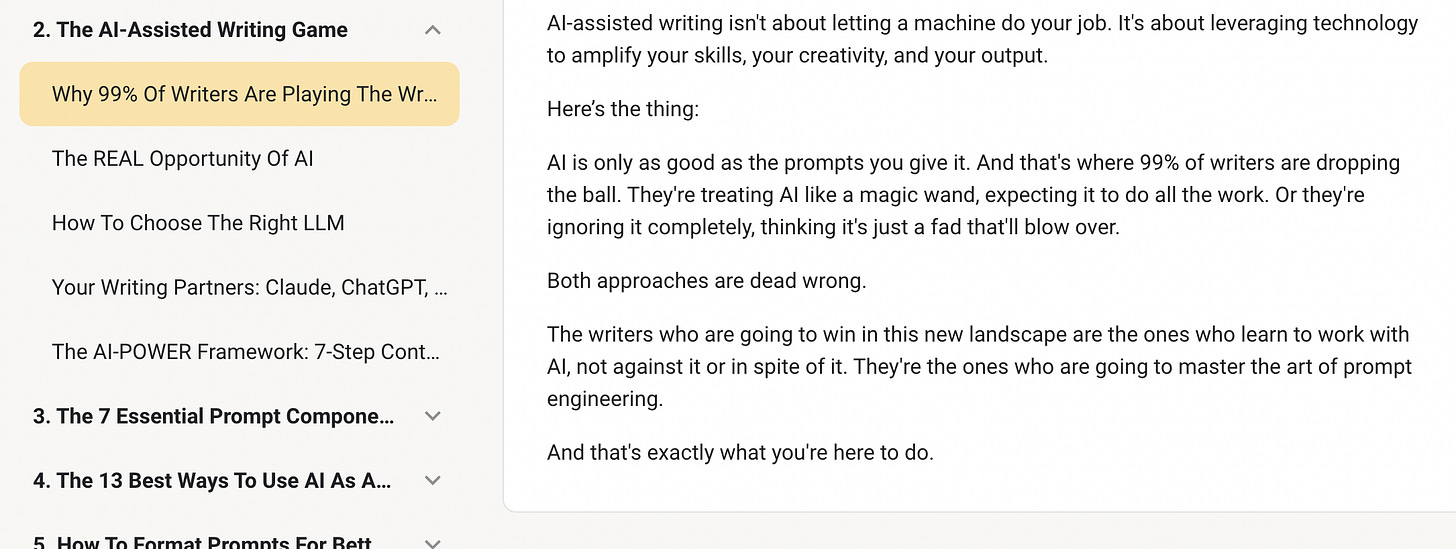How To Write The Perfect Course Module With AI
Last week, we launched our most comprehensive AI-writing product yet:
The Prompt Engineering Playbook for Digital Writers.
As much as we’d love to create all the prompt templates our readers ask us for, the truth is that we can’t. And even if we could, you might actually not want US to do that for you.
Which is why we’ve finally created a product to help you:
Master the art of Prompt Engineering
Train AI to write exactly like yourself
And 10x your content (without spending hours manually editing the output of your AI).
So, if you’re ready to scale yourself with AI, we’d love to help you get there as quickly as possible.
Click here to grab the Prompt Engineering Playbook—and fast-track your content creation today.
Hey there Digital Writers!
In 2014, I launched my first digital product and made my first $10,000 on the Internet.
Since then, I’ve:
Sold over $10 million worth of ebooks and courses
Guided more than 12,000 students through various programs
Written over 3 million words
I’ve learned a thing or two about how to create a product that sells and delivers results.
Which is why today I'm going to share my method for creating the perfect course module. This framework ensures your students not only understand the material but also feel confident enough to take action and achieve their goals.
So, if you're creating an online course, thinking about building one, or if you already have a course but want to improve it—I got you.
Whether it's to:
Increase your student success rate
Create positive word of mouth (because your curriculum is that good)
Or simply to ensure people absolutely love your product—you’ll love this framework.
And to make things even simpler, I’ve got an AI prompt for you at the end of this post that will help you create your course modules fast.
But first, let’s dive into the five essential components that every course module needs to include.
The 5 Components Of A Perfect Course Module
Every single module in your online course curriculum needs to have these five components:
Reasons Why (Benefits)
Mistakes to Avoid (Problems)
Steps How To (Action)
Commonly Asked Questions (Objections)
Walkthrough Example (Proof)
Let’s break down each of these components and why they’re crucial to the success of your course.
1. Reasons Why (Benefits)
Before you dive into action steps, you need to ground your students with the “why.”
This isn’t just about telling them what to do but explaining why they should do it this way. For example, in our brand new course, The Prompt Engineering Playbook, we start by explaining why “grinding it out” as a writer is a thing of the past. We outline everything that’s wrong with thinking AI will steal your job as a writer and emphasize the benefits of leveraging technology instead. If you don’t take the time to address these foundational questions, you’re starting from a flawed place of understanding.
It’s not enough to say, “Here’s what you should do.” You need to say, “Here’s why I recommend this, and here are the benefits of doing it this way.”
2. Mistakes to Avoid (Problems)
Once you’ve established the benefits, it’s time to warn your students about the common pitfalls they might encounter.
This step is crucial because it builds trust. You’re not just showing them the path; you’re also guiding them around the obstacles. For example, in our beginner writing program, Ship 30 for 30, after explaining the benefits of writing on social platforms, we point out the mistakes most people make when they start writing online, like getting too caught up in virality.
By highlighting these pitfalls, you help your students avoid common errors and gain confidence in the process.
3. Steps How To (Action)
This is the meat and potatoes of your course—the action steps.
But notice, you can’t just dive right into the steps. First, you need to establish the thinking and direction, address the mistakes to avoid, and then—only then—can you give them the tangible steps to take. A common mistake I see in online courses is diving straight into the “how to” without properly setting the stage. Another mistake is providing surface-level instructions that leave too many open loops.
You need to go seven layers deep in your action steps, removing every single piece of friction possible.
4. Commonly Asked Questions (Objections)
After you’ve provided the action steps, it’s important to address the objections your students might have.
I’ve found that objections are often disguised as questions. For example, someone might ask, “Is my niche really on LinkedIn?” when what they’re really saying is, “I don’t think this will work for me.”
By addressing these objections head-on, you dismantle faulty beliefs and reassure your students that they’re on the right track.
5. Walkthrough Example (Proof)
Finally, you need to provide some sort of walkthrough example.
This isn’t just a testimonial; it’s a tangible example that shows exactly how you or another student did it. In our PGA curriculum, for instance, we include a video where I demonstrate how to do free consulting via Loom. Then, I take it a step further by recording myself rewatching the video, pausing to explain why I did what I did.
This level of depth instills trust and confidence in your students. By the time they finish the module, they should have no other questions. They should know exactly what to do, why to do it, what to avoid, and believe that it will work for them.
Write Your Course Module With AI
Now that you understand the five key components of a perfect course module, let's look at how you can use AI to speed up the creation process.
You can use this prompt with ChatGPT (or any other LLM) to write your first draft.
Here’s the prompt:





